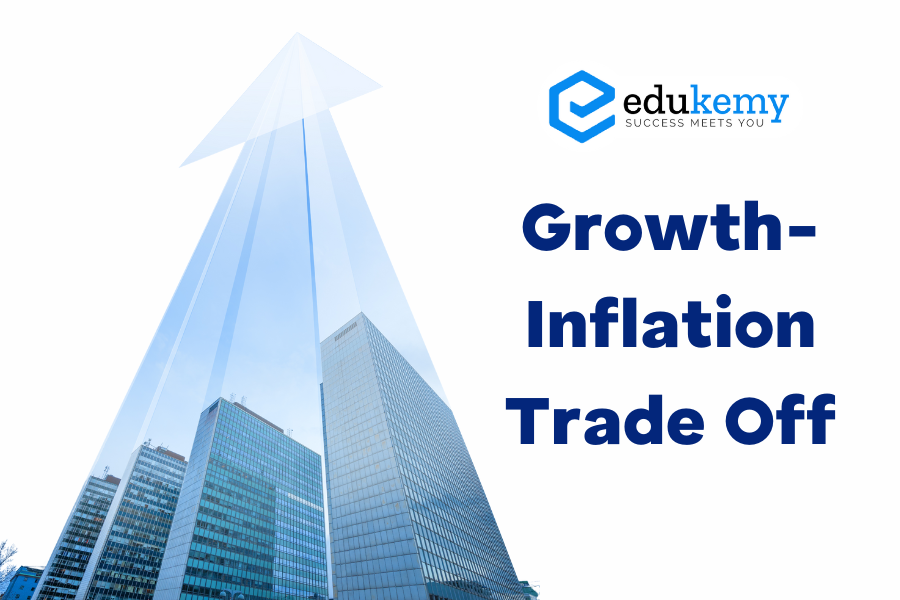
The growth-inflation trade-off is a key concept in macroeconomics and monetary policy. Here’s a breakdown of the dynamics involved:
- High Growth and Inflation:
- Overheating of the Economy: Rapid economic growth can lead to an overheating of the economy. This occurs when demand outpaces supply, putting upward pressure on prices.
- Rising Incomes and Demand: High growth results in increased employment, higher incomes, and greater consumer demand. This, in turn, contributes to inflationary pressures.
- Central Bank Intervention:
- Role of the Central Bank (RBI): In response to rising inflation, the central bank (in this case, the Reserve Bank of India – RBI) intervenes.
- Tools of Intervention: The central bank uses tools such as the repo rate, cash reserve ratio (CRR), and open market operations (OMOs) to signal its intention to control inflation.
- Effect on Growth:
- Dampening Impact: The central bank’s intervention, often involving an increase in interest rates, has a dampening effect on economic growth.
- Reduced Borrowing: Higher interest rates make borrowing more expensive, leading to reduced investment and consumption demand.
- Trade-Off in the Short Term:
- Intimate Connection: Growth and inflation are intimately connected, and there is a trade-off between the two in the short term.
- Central Bank’s Mandate: The primary goal of the central bank, as mandated by the inflation targeting framework, is to moderate and stabilize prices.
- Long-Term Perspective:
- Temporary Pauses: Overheating and economic slowdown are viewed as temporary pauses in the context of long-term economic growth.
- Growth as a Marathon: Growth is likened to a marathon, suggesting that occasional pauses or adjustments are necessary for sustained and robust long-term growth.
- Importance of Real Interest Rates:
- Negative Real Interest Rates: It’s emphasized that maintaining positive real interest rates is crucial. If interest rates do not keep pace with inflation, real interest rates become negative.
- Impact on Savings: Negative real interest rates could discourage savings and redirect funds to unproductive assets like gold, potentially leading to economic imbalances.
In summary, the growth-inflation trade-off involves a delicate balancing act for central banks. While pursuing economic growth, it’s essential to manage inflation to avoid long-term economic disruptions. The effectiveness of monetary policy tools and their impact on the real economy are critical considerations in this process.
Contents
- 1 FAQs
- 1.1 1. What is the growth-inflation trade-off?
- 1.2 2. Why is it important to manage the growth-inflation trade-off?
- 1.3 3. How do policymakers address the growth-inflation trade-off?
- 1.4 4. Can a country achieve both high growth and low inflation simultaneously?
- 1.5 5. What are the risks of ignoring the growth-inflation trade-off?
- 2 In case you still have your doubts, contact us on 9811333901.
FAQs
1. What is the growth-inflation trade-off?
A: The growth-inflation trade-off refers to the dilemma policymakers face when trying to balance economic growth with controlling inflation. Economic theory suggests that stimulating growth often leads to inflation, while efforts to curb inflation can sometimes hinder growth.
2. Why is it important to manage the growth-inflation trade-off?
A: Managing the growth-inflation trade-off is crucial for maintaining macroeconomic stability. Excessive inflation can erode purchasing power and destabilize markets, while insufficient growth can lead to unemployment and stagnation. Finding the right balance ensures sustainable economic development.
3. How do policymakers address the growth-inflation trade-off?
A: Policymakers use various tools such as monetary policy, fiscal policy, and supply-side measures to navigate the growth-inflation trade-off. Central banks adjust interest rates to influence borrowing and spending, while governments manage public spending and taxation to stimulate or cool down economic activity.
4. Can a country achieve both high growth and low inflation simultaneously?
A: While challenging, it’s possible for a country to achieve both high growth and low inflation through prudent policymaking and structural reforms. For instance, investing in productive infrastructure and improving productivity can boost growth without significantly fueling inflation.
5. What are the risks of ignoring the growth-inflation trade-off?
A: Ignoring the growth-inflation trade-off can lead to adverse consequences such as stagflation, where high inflation coincides with stagnant growth, or overheating, where excessive growth fuels inflationary pressures. Both scenarios can undermine economic stability and hinder long-term prosperity. Therefore, policymakers must carefully monitor and manage this trade-off.
In case you still have your doubts, contact us on 9811333901.
For UPSC Prelims Resources, Click here
For Daily Updates and Study Material:
Join our Telegram Channel – Edukemy for IAS
- 1. Learn through Videos – here
- 2. Be Exam Ready by Practicing Daily MCQs – here
- 3. Daily Newsletter – Get all your Current Affairs Covered – here
- 4. Mains Answer Writing Practice – here

